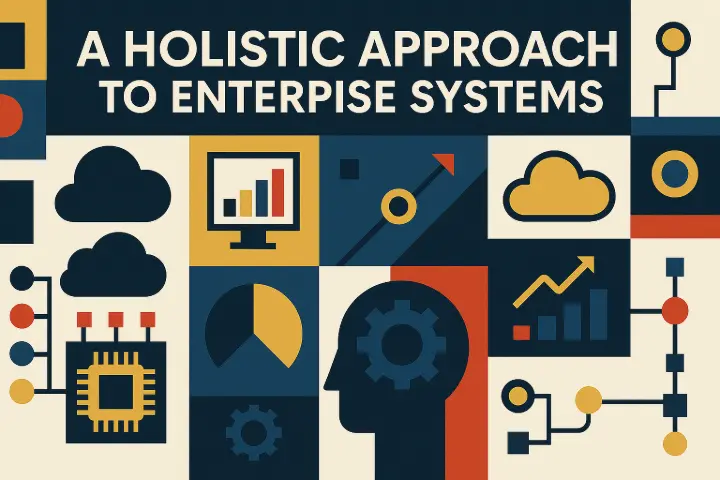
This series explores the pain points of a disjointed application ecosystem and key considerations for a successful ERP implementation. Over the course of several installments we’ll focus on why simplifying your application landscape and adopting a holistic approach are critical to success. Each article addresses specific challenges and strategies to help organizations maximize the value of their ERP investment.
Understanding Application Sprawl - The Hidden Cost of Business Operations
The Modern Business Application Landscape
Have you ever wondered why so many organizations find themselves drowning in a sea of disconnected software applications? The modern business application ecosystem has evolved into an increasingly complex and fragmented environment. Organizations today rely on a multitude of disconnected applications - QuickBooks for accounting, ShipStation for logistics, Concur for expense management, and countless others - each supporting a discrete operational function within the organization. This type of disparate application landscape has become the norm for many businesses, particularly those that have grown organically without any system architecture strategy.
While these point solutions solve the immediate need, they create a fragmented system environment that ultimately undermines operational efficiency, data integrity, and organizational agility. Each additional application introduces new complexities contributing to integration challenges, increasing data silos, and process gaps that together impact business performance and increase the cost to maintain systems. Like a sailor without a compass, businesses without a rational application strategy will find themselves adrift, struggling to scale operations turning valuable system assets into liabilities that hold your business back.
The True Cost of Application Sprawl
Understanding the underlying purpose of your application ecosystem is critical to success. If you can't articulate what each application is trying to accomplish and why it exists separately from others, this is a clue that you may need to examine your technology landscape more critically.
Beyond the obvious licensing costs, application sprawl creates numerous hidden expenses:
1. Integration complexity: Each interface between systems requires development, testing, and maintenance resources. This is a common source of technical debt that keeps accumulating with each passing year and only increases with the number of systems.
2. Data inconsistency: Multiple systems of record lead to conflicting information and manual reconciliation efforts. Which system should you trust when they disagree? You end up spending time and money correcting data rather than growing your business.
3. Process inefficiency: When your employees struggle to work in multiple silos, some integrated, others with manual swivel chair processes spanning multiple applications, this leads to bottlenecks and opportunities for error. Each handoff between systems is a potential point of failure which leads to further cost and delay.
4. User productivity losses: Staff must learn and navigate multiple interfaces, authentication systems, and inconsistencies in data structures. One way this shows up in your business environment is seeing the same data with three or four different names depending on the system? The cognitive load on employees of bridging these inconsistencies can be substantial.
5. Security vulnerabilities: Each additional application expands the potential attack surface for security threats. More doors mean more opportunities for unwanted visitors, and greater time and cost to ensure all your systems are up to date with the latest security patches. Your security is only as secure as your weakest system or vendor.
Identifying Signs of Problematic Application Sprawl
How do you know if your organization suffers from harmful application sprawl? Ask yourself "why" your application landscape looks the way it does. If the answer is "because that's how it evolved" rather than "because it serves our strategic needs," you may have a problem.
Clues include:
- Users regularly accessing 5+ applications to complete common tasks.
- Data discrepancies between systems requiring reconciliation.
- Difficulties in obtaining accurate and complete operational reports.
- Ever increasing IT budgets weighted toward maintenance, bug fix, and ad hoc scripts to fix data.
- Inability to quickly adjust to market changes due to long development lead teams updating your systems.
Most people don't start out with the goal of building a fragmented and inefficient application ecosystem. Why then do so many businesses end up with this problem? Competing priorities, short-term thinking, and miscommunication often cause companies to neglect their broader technology landscape.
In our next article, we'll explore how ERP systems can address these challenges - and why simply dropping an ERP to your existing landscape is not the solution.
If you’re struggling with inefficient systems and processes, or you’re been considering an ERP implementation but don’t know where to start, Bearded Moose can help you achieve your business goals with a modern application suite.
Bearded Moose
Technology solutions tailored to your Business.
Our full-suite custom software engineering services cover everything from web to mobile solutions. We don't just create software; we engineer experiences that are intuitive, reliable, and scalable. Whether you're looking for a stunning website, a powerful mobile app, or a complex enterprise system, our expert engineers can turn your most ambitious visions into reality.
#odoo
https://www.beardedmoosetech.com/
https://www.linkedin.com/company/bearded-moose/
Contact Us
Book a Meeting